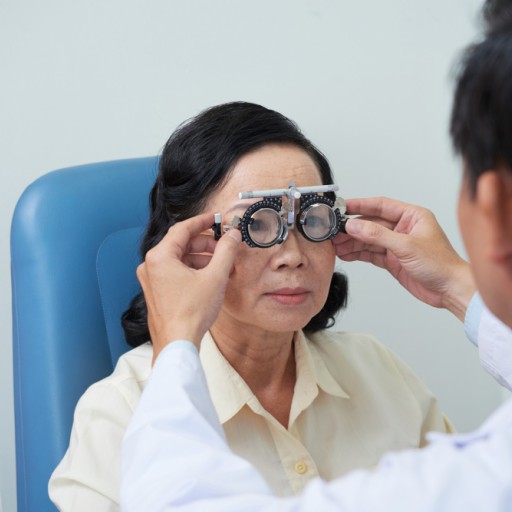Refractive Diseases
1 results foundRefractive Diseases
Refractive disorders are vision problems that occur when the eye is not capable of focusing light properly onto the retina, often resulting in blurred vision. The common types are myopia, or nearsightedness; hyperopia, or farsightedness; astigmatism; and presbyopia, age-related changes that affect vision. Millions of people in every part of the world are suffering from these vision problems, which commonly disturb daily activities.
With an advance in the field of medical technologies, several treatment methods have been invented to rectify these disorders. In fact, these treatment methods are forged with quality intentions of life to ensure that there is a total or reduced dependency on either glass or contact lenses.
What Are Refractive Disorders?
Refractive disorders are the conditions that affect the mechanism of focusing of light by the eye. Normally, light entering the eye is regularly focused directly onto the retina, allowing clear vision. In cases of refractive disorders, the process is impaired and causes blurry or distorted vision. Often, these types of disorders can either be congenital or acquired, normally arising due to a particular structure of the eye or curvature of the cornea.
Types of Refractive Disorders
Refractive disorders can be classified into several major types, the following are a few of them:
Myopia or Nearsightedness: This is a disorder wherein the object very far away appears hazy, but near objects appear clear. It occurs in conditions when the eyeball has grown too long or the cornea is curved too steeply.
Hyperopia: A condition whereby an object near is not seen, but in some instances, the farther away it is, the better it can be seen. This may be because the eyeball may be too short or the cornea has too little curvature.
Astigmatism: This is when there is an irregular shape of the cornea or lens that may cause blurred or distorted vision at all distances. There is a failure of light rays focusing evenly on the retina.
Presbyopia: This is a well-known age-related condition that eventually affects the ability to see close objects clearly, usually beginning in the early to mid-40s.
Causes of Refractive Disorders
The causes of refractive disorders may range from diverse elements including:
Genetic factor: It can be due to family history that plays a significant role in these errors of refraction.
Environmental Factors: Prolonged use of screen time and decreased outdoor activities have been associated with the increasing prevalence of myopia, especially among children.
Structure of the Eye: The shape and structure of the eye may vary in the length of the eyeball, curvature of the cornea, or shape of the lens. These variations will make the light entering the eye be focused incorrectly, hence one will not be able to clearly see objects.
Diagnosis of Refractive Disorders
Refractive disorders are generally diagnosed with a comprehensive eye exam by an optometrist or an ophthalmologist. These may include the following:
Visual Acuity Test: This measures the sharpness of your vision at both near and far distances.
Refraction Test: This measures the degree to which light entering the eye needs to be bent to achieve proper focus.
Keratometry: This measures the curvature of the cornea.
Pupil dilation: this allows for a more adequate view of the internal eye structures.
Treatment Options of Refractive Disorders
There are several avenues of treatment for refractive disorders:
Spectacles: the most common and least invasive. Lenses are prescribed according to the specific refractive error in order to correct vision.
Contact Lenses: A no-glasses alternative, these lenses sit right on your eye, offering a wider range of view, for instance.
Refractive Surgery: The surgical options include LASIK or PRK, which reshape the cornea to allow better focus; often chosen for long-term correction.
Orthokeratology: You wear special contact lenses at night that temporarily reshape your cornea so that your distant vision can be clear without wearing glasses the next day.
Prevention
Although a few of these refractive disorders could be genetic, the following precautions help keep the eyes healthy and, to an extent reduce the possibilities of vision problems.
Regular Check-ups: This will help in early detection of the refractive error.
Healthy Life: A healthy diet with ample vitamins and minerals helps maintain general eye health.
Avoid Continuous Screen Exposure: Excessive use of screens and other electronic media result in eye strain. One must take breaks while working on focussed screen-based devices.
Outdoor Activities: Myopia is less common in children who spend a lot of time outdoors.
Living with Refractive Disorders
Most people manage refractive disorders with the use of corrective glasses, contacts, or surgery. One doesn't necessarily need to live life with these conditions at hand. Over the course of due treatment, people suffering from these disorders are very well capable of continuing their day-to-day activities, enjoying every hobby, and keeping themselves active.
Refractive disorders rank among the common vision problems that can substantially affect daily living. For any form of impairment to be managed, the types, causes, and treatment alternatives have to be clearly understood. There are myriad ways to achieve better vision: through eyeglasses, contact lenses, or surgical interventions, just to name a few. If you think you have one of these eye disorders, it is necessary to consult with an eye care professional to explore options that best suit your needs.

